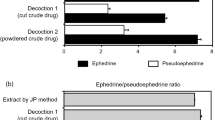Abstract
Ephedrine, also called ephedrine ingot, L-ephedrine, is from dry grass stems of ephedra plants such as ephedra, Zhong ephedra, and Equisetum ephedra. Ephedrine is a white needle-like crystal or crystalline powder and odorless. It is soluble in water and can be dissolved in ethanol but is insoluble in chloroform or ether. Dosage forms of ephedrine are mainly tablets, injections, and eye drops, and they were used widely in clinical practice. Ephedrine was first isolated from the herb “Shuanghui Ephedra” in 1885. Ephedrine was successfully synthesized in 1920. In 1926, ephedrine was approved in clinical practice by the FDA of the United States. Structure of ephedrine was defined in 1926. Ephedrine hydrochloride was used for the treatment of bronchial asthma, hypotension, and central excitation. The side effects of ephedrine hydrochloride are anxiety, insomnia, palpitations, sweating, and other symptoms. Ephedrine is rarely used for asthma treatment now.
Access this chapter
Tax calculation will be finalised at checkout
Purchases are for personal use only
Similar content being viewed by others
References
Botanical nomenclature, Shanghai, 1917;1004.
Lock M. East Asian medicine in urban Japan: varieties of medical experience. University of California Press; Reprint edition 1984. ISBN 0-520-05231-5.
Nagai N, Pharm Z 1887;xxxii: 700.
Späth E, Gökring R, Monatsh F. Chemistry. 1920;xli:319.
Chen K, Schmidt CF. J Pharmacol Exp Ther. 1924;xxiv:339.
Ruben JE, Kamsler PM, Howell WL Jr. The spinal anaesthetic effects of ephedrine sulfate: a preliminary report. Science. 1948;107(2774):223.
von Mutius E, Drazen JM. A patient with asthma seeks medical advice in 1828, 1928, and 2012. N Engl J Med. 2012;366(9):827–34.
Cannon C, Cowan F, Koppanyi T, et al. Explanation of cocaine desensitization of blood pressure responses to ephedrine. Science. 1961;134(3485):1075–7.
Eldaba AA, Amr YM. Intravenous granisetron attenuates hypotension during spinal anesthesia in cesarean delivery: a double-blind, prospective randomized controlled study. J Anaesthesiol Clin Pharmacol. 2015;31(3):329–32.
Author information
Authors and Affiliations
Corresponding author
Rights and permissions
Copyright information
© 2018 Springer Nature Singapore Pte Ltd. and People's Medical Publishing House, PR of China
About this chapter
Cite this chapter
Wang, JH., Yang, XY., Du, GH. (2018). Ephedrine. In: Natural Small Molecule Drugs from Plants. Springer, Singapore. https://doi.org/10.1007/978-981-10-8022-7_38
Download citation
DOI: https://doi.org/10.1007/978-981-10-8022-7_38
Published:
Publisher Name: Springer, Singapore
Print ISBN: 978-981-10-8021-0
Online ISBN: 978-981-10-8022-7
eBook Packages: Biomedical and Life SciencesBiomedical and Life Sciences (R0)



